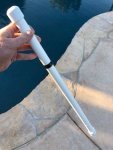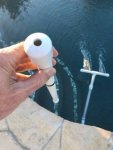14,000 gallon plaster pool with the following readings:
PH - 7.5-7.6
CH - 300
FC - 5
TC - 5
TA - 60
CYA - <30
Water Temp - 90-91 F
This summer I started the season with a CYA somewhere under 30 (no cloudiness at the top of the tube on the Taylor kit). I used trichlor pucks to start the season. I got the CYA to 45-50, and switched over to liquid chlorine. I add muriatic acid to keep the PH in the 7.4-7.6 range. With the hotter temperatures in Houston, I get really light yellow algae outbreaks a few times a summer. It starts on the rocks under my waterfall. As soon as I see any yellow algae coming off during my weekly brushing, I hand brush the entire pool, shock it with Cal Hypo (CH was 180 when I started the summer) up to 30 ppm, vacuum the dead algae with the robot vacuum, and then clean all of the pool equipment. This usually leaves the pool perfect for 6-8 weeks until the next signs of algae appear. I am OK with this process. I always keep the FC up to advised levels for stopping yellow algae. I think with the hot temperatures and extensive landscaping around the pool (dropping debris in daily), yellow algae is just a part of life for the pool. And I am happy to maintain it this way. It never gets out of control or stops the pool's use.
Having said that, I checked my CYA levels last week, and the CYA is back to somewhere under 30. It is likely around 10-15 as the water is cloudy in the tube, but not anywhere near making the dot disappear. My understanding is that unless you have a leak or severe splash out, your CYA levels should stay relatively stagnate over time. Mine is anything but that.
Is there a mixture of warm temperature and algae blooms that will eat the CYA? That is the only thing I can figure. I am not really complaining because using pucks to bring it back up is easier than adding liquid chlorine. But curious chemically if this is a known issue.
PH - 7.5-7.6
CH - 300
FC - 5
TC - 5
TA - 60
CYA - <30
Water Temp - 90-91 F
This summer I started the season with a CYA somewhere under 30 (no cloudiness at the top of the tube on the Taylor kit). I used trichlor pucks to start the season. I got the CYA to 45-50, and switched over to liquid chlorine. I add muriatic acid to keep the PH in the 7.4-7.6 range. With the hotter temperatures in Houston, I get really light yellow algae outbreaks a few times a summer. It starts on the rocks under my waterfall. As soon as I see any yellow algae coming off during my weekly brushing, I hand brush the entire pool, shock it with Cal Hypo (CH was 180 when I started the summer) up to 30 ppm, vacuum the dead algae with the robot vacuum, and then clean all of the pool equipment. This usually leaves the pool perfect for 6-8 weeks until the next signs of algae appear. I am OK with this process. I always keep the FC up to advised levels for stopping yellow algae. I think with the hot temperatures and extensive landscaping around the pool (dropping debris in daily), yellow algae is just a part of life for the pool. And I am happy to maintain it this way. It never gets out of control or stops the pool's use.
Having said that, I checked my CYA levels last week, and the CYA is back to somewhere under 30. It is likely around 10-15 as the water is cloudy in the tube, but not anywhere near making the dot disappear. My understanding is that unless you have a leak or severe splash out, your CYA levels should stay relatively stagnate over time. Mine is anything but that.
Is there a mixture of warm temperature and algae blooms that will eat the CYA? That is the only thing I can figure. I am not really complaining because using pucks to bring it back up is easier than adding liquid chlorine. But curious chemically if this is a known issue.



